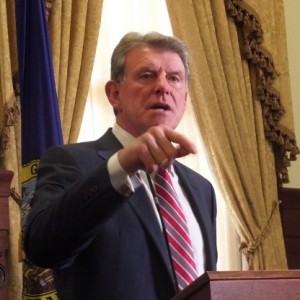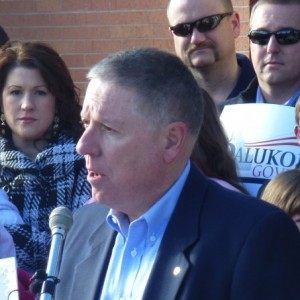Since July 1, 2007 — and during Butch Otter’s two terms as governor — school districts have backfilled their budgets with more than $1 billion in supplemental property tax levies.
The amount of the levies has steadily grown during Otter’s first eight years in office. So too has districts’ reliance on these short-term voter-approved levies.
Idaho Education News analyzed supplemental property tax levy figures from 1992 through June 30. The analysis uses July 1, 2007 as a breakpoint, for several reasons. The date roughly coincides with Otter’s election as governor. Ten months earlier, at the urging of then-Gov. Jim Risch, lawmakers approved a tax shift that eliminated most school property taxes and raised the sales tax to cover much of the difference. And July 1, 2007 predates the Great Recession, which saw Idaho impose a series of unprecedented cuts in K-12 funding.

The results:
- From July 1, 2007 through June 30, a seven-year period, the schools collected $956.2 million in levies, an average of $136.6 million per year.
- From July 1, 1992 through June 30, 2007, a 15-year period, districts collected $867.9 million. That averages out to $57.9 million a year.
Supplemental levy numbers for 2014-15 — the current budget year, which began July 1 — won’t be available for several weeks. But when those numbers are factored in, the cost of supplemental levies during Otter’s tenure will easily eclipse the $1 billion mark.
The commonplace levy
Supplemental property taxes generally run one to two years, and require a simple majority to pass. There is nothing new about this taxing authority. Some levies have been in place for years, routinely renewed by local voters. But since 2007, supplemental levies have grown almost commonplace across Idaho.
Ninety-one of Idaho’s 115 school districts had a supplemental levy on the books in 2013-14, up from 59 districts in 2006-07, the budget year that ended on June 30, 2007.
Levies have become widespread — in larger, urban districts with a robust property tax base, and in smaller, rural communities as well. Supplemental levies are collected in at least part of every county in the state.
The 91 districts with supplemental levies accounted for a combined 2013-14 enrollment of 247,587, or close to 92 percent of the 269,598 students attending Idaho’s public schools. (An additional 19,367 students attend Idaho charter schools — and these schools cannot collect property taxes.)
Political reactions
Otter: He believes the state has a “sustainable and apolitical” five-year plan to address the funding gaps, spokesman Jon Hanian said in a statement.
This plan originates from Otter’s education reform task force, which met through August 2013. Among other items, the task force recommended restoring district “operational funds” that were slashed during the recession, and establishing a teacher career ladder to boost salaries and help rural districts hold onto experienced teachers.
The Republican Otter and the 2014 Legislature restored $35 million in operational funds; reversing these cuts could cost an additional $78 million.
The task force also recommended stabilizing state K-12 funding from year to year, “which is a noble goal,” said Hanian.

A.J. Balukoff: The Democratic gubernatorial candidate says the spate of levies reflects the state’s “disinvestment” in education — and shows that Idaho’s elected officials have ignored the state’s constitution, which mandates a “general, uniform and thorough” public school system. The levies also belie Otter’s claim that he has cut taxes while in office.
“Many if not most Idahoans have seen their tax bills increase under Gov. Otter, at the same time that Idaho has raced to the bottom nationally in statistics like per-capita personal income and how much our state invests per pupil,” Balukoff said in a statement.
Balukoff is a member of the Boise School Board — and Boise collects more in supplemental levies than any district in Idaho. Boise voters approved a five-year, $70 million levy in 2012, although the district has never collected that full amount.
Jana Jones: Supplemental levies are no longer used for their original purpose: to fund new programs and innovations. Now, says the Democratic state superintendent’s candidate, they are used just to keep districts afloat. Like Balukoff, Jones believes there is a large gap between districts that can pass a levy and those that are forced to make additional cuts. “All we’ve done is shift the tax burden down to the local taxpayers,” she said Tuesday.
Sherri Ybarra: The GOP state superintendent’s candidate places some of the blame on the 2006 tax overhaul, engineered by Risch and approved by many, but not all, Republican legislators. “I recognize this tax shift in 2006 destabilized education funding in Idaho; however this balance between those forms of taxation is completely up to the Legislature.”
Tom Luna: The outgoing state superintendent — the Republican Ybarra and Jones seek to succeed — does not blame the 2006 tax shift, but instead blames the recession. When tax revenues plummeted, the state was forced to cut K-12 funding, but Luna believes Otter and the Legislature are making good on plans to restore funding. “I think we’ve been on that path since the recession ended,” Luna said Wednesday.
A partial replacement
Politics aside, the growth of the supplemental levy occurred as the state was cutting K-12 funding, and using money from the federal economic stimulus package to pick up some of the slack.
But the locally passed supplemental levies replaced only a fraction of the money cut from state funding.
The Legislature passed a $1.418 billion general fund budget for K-12 in 2008-09. That’s a high water mark that still hasn’t been reached since.
In 2010-11, the K-12 budget bottomed out at $1.214 billion, a decrease of $204 million dollars.
The statewide tally of supplemental levies increased by $28.2 million from 2008-09 to 2010-11, and an additional $51.8 million since then.
More reading: A closer look at Idaho’s supplemental levies, by the numbers.
